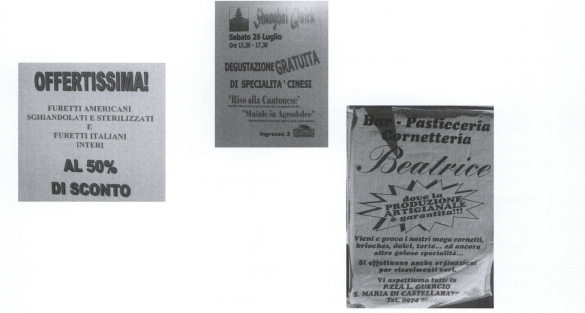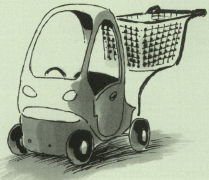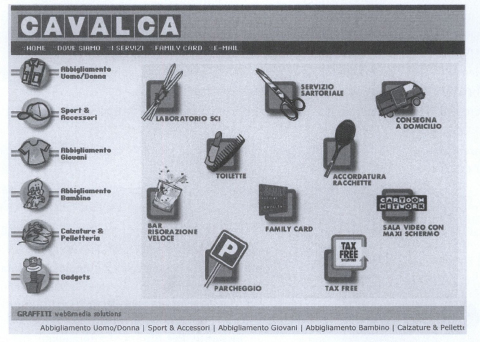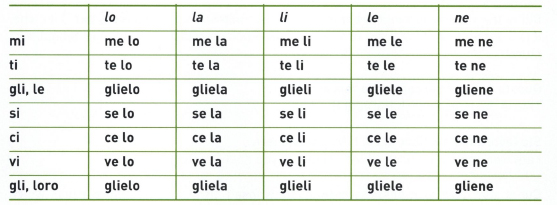 1 Unscramble the slogans
1 Unscramble the slogansUnit 19
Pubblicità, promozione e prodotti
 1 Unscramble the slogans
1 Unscramble the slogans
The slogans for these products have got scrambled. Can you guess which slogan belongs to which and match them up?

 2 Da or per?
2 Da or per?
Anna has been on a shopping trip! Look at the list of things she has bought and complete it by adding either da or per, both of which express purpose, and the definite article (il, la) where necessary. The first one is done for you.
1 una macchina ______da cucire
2 una macchinetta ______ caffè
3 una scatola ______ giocattoli
4 un barattolo ______ marmellata
5 una camera ______ letto
6 un costume ______ bagno
7 le scarpe ______ montagna
8 le scarpe ______ camminare
9 gli occhiali ______ sole
10 un ombrello ______ pioggia
11 un tappeto ______ salotto
12 una pentola ______ spaghetti
13 un’asciugamano ______ spiaggia
14 una bicicletta ______ corsa
15 una crema ______ viso
 3 Expressing purpose
3 Expressing purpose
Here two possible reasons are supplied for each statement. See if you can work out which is the right one.
1 Mangio solo pane
a per risparmiare.
b per dimagrire.
2 Leggo Oggi
a per essere più informato.
3 Volo con “Easyfly”
a per spendere di meno.
b per arrivare prima.
4 Frequento il Tennis Club
a per conoscere gente per bene.
b per giocare a tennis.
5 Ho preso la Carta Blu
a per pagare più facilmente,
b per spendere di più.
6 Ho comprato dei funghi
a per fare un bel risotto.
b per fare un picnic.
7 Ho studiato i verbi irregolari
a per poter passare l’esame.
b per divertirmi.
8 Ho installato la tv a satellite
a per vedere la televisione italiana.
b per ascoltare la musica classica.
9 Ho fatto la dieta
a per dimagrire.
b per ingrassare.
10 Ho comprato dei libri
a per studiare.
b per diventare famosa.
Expressing purpose
Purpose of objects
There are many words where the purpose of the objects has become closely linked to the object itself, using da, for example:
una macchinetta da caffè |
coffee machine |
una macchina da cucire |
sewing machine |
Per can also be used to express purpose:
Preparo la lezione per la classe di stasera.
I’m preparing the lesson for tonight’s class.
Clauses expressing purpose
Purpose can be expressed in a simple way using per or allo scopo di and the infinitive. This only works if the subject is the same in both parts of the sentence:
Sono andata a Perugia per imparare l’italiano.
I went to Perugia to learn Italian.
If two different subjects are involved, purpose can be expressed by using perché or affinché followed by the subjunctive:
Mandiamo i nostri studenti a Perugia perché (affinché) imparino l’italiano.
We send our students to Perugia so that they can learn Italian.
Abbiamo mandato i nostri studenti a Perugia perché (affinché) imparassero l’italiano.
We sent our students to Perugia so that they could learn Italian.
 4 Per
4 Per  perché
perché
In the sentences given below, per and a simple infinitive are used. Change these sentences to involve another person, using the words in brackets, so that you have to use perché and the present subjunctive. You may have to alter the verbs or even use different ones. The first one is done for you.
Example
Compro Dash per avere vestiti più puliti. (i miei figli)
Compro Dash perché i miei figli abbiano vestiti più puliti.
1 Compro Dash per avere i vestiti più puliti. (i miei figli)
2 Compro caffè Lavazza per bere un caffè migliore. (i miei amici)
3 Scelgo una macchina tedesca per viaggiare più sicuro, (i miei passeggeri)
4 Scelgo le Dolomiti per rilassarmi quest’estate, (tutta la famiglia)
5 Vengo alla scuola di lingua Cursus per imparare di più. (mando i miei studenti)
6 Compro ragù Borroni per mangiare meglio. (perché i miei ospiti)
7 Uso la crema Ogay per avere una pelle più morbida. (perché la mia pelle)
8 Indosso i jeans Guest per essere invidiata da tutte, (perché le mie amiche/invidiose di me)
9 Compro i CD a Mondo della Musica per pagare di meno, (dico agli amici di comprare/perché …)
10 Leggo il Sole 24 Ore per essere più informato. (mettere in biblioteca/gli studenti)
 5 Change present
5 Change present  past
past
Now change your answers for Activity 4 into the past tense, to say what you did or used to do.
Example
Compro Dash perché i miei figli abbiano vestiti più puliti.
Ho sempre comprato Dash perché i miei figli avessero vestiti più puliti.
GRAMMAR NOTES II
The language of advertising
Advertising language demonstrates some interesting characteristics. A typical printed advert might have one or more of a number of features.
Imperative forms
Scegliete la Grecia per trascorrere una vacanza in totale relax.
Rhymes
Più Tin – Più Win
Use of English
English is used a lot in Italian advertising, especially for products aimed at young people, business people and would-be ‘jet-setters’. Short easy words are used to make the advert more accessible:
I feel, I feel good
Yesterday – Today – Tomorrow
Parallel structures
Tu ci porti il tuo vecchio stereo. Noi ti portiamo il cinema a casa.
Standard advertising vocabulary
Don’t forget these important key words:
Conveniente
Economico
Superlative forms
Suffixes and prefixes such as -issimo, arci-, iper- are very common in advertising language:
Offertissima!
Adverbs are often used too:
veramente
estremamente
Gioco di parole
C’è Rivoluzione e RiVolazione
(advert for Meridiana Airlines, November 2002)
Nuovo Vanish Oxa Action E
la macchia svanish!
(advert for Vanish stain remover)
Condiriso incontra il mare.
Molto piacere!
(advert for rice product)
Personalised appeals
Adverts are often personalised with tu and tuo, making a direct appeal (see Text 19.1).
Text 19.1 Centro Commerciale Cavalca
Il piano inferiore è dedicato alla fantasia, con gli oggetti, le idee, le soluzioni che ti aspetti da Cavalca: poster, profumatori, candele, vasi, cornici, fiori, idee regalo e migliaia di cartoline per tutte le occasioni. Da scegliere fra simpatia e colore, per regalare un tocco in più alla tua casa … il tutto a prezzi Cavalca.
Adapted from Centro Commerciale Cavalca website

 6 Make up your own advert
6 Make up your own advert
Now that you have seen lots of adverts, it’s time to make up your own. Here are some products or services that you are trying to promote and a List of suggested USPs (unique selling points!). Work with your partner to create an exciting advert. Have fun!
Prodotto |
USP |
• La tua università |
Alloggio? Corsi? Professori? Situazione? |
• I criceti (hamsters) |
Piccoli. Affettuosi. Vivono solo per due anni. |
• Domino’s Pizza |
Non è la pizza italiana. Costa molto. |
• Un tuo amico |
Simpatico. Bello. Costa poco. |
• La Skoda |
Costa poco. Colori originali. |
• Newcastle, UK |
Pochi turisti. Birra molto buona. Tranquilla? |
 7 Centro Commerciale Gabbiano, Savona
7 Centro Commerciale Gabbiano, Savona
Now let’s have a look at the places people shop: shopping malls or centri commerciali. Where can you buy or do the following at the Centro Commerciale Gabbiano?
1 Buy a new screwdriver
2 Buy some pizza to take away
3 Get your photos developed
4 Buy a wedding present for your friend
5 Buy a new washing machine
6 Buy some stamps
Kasanova
Negozi per la casa e lista nozze. Quel tocco in più che hai sempre sognato per la tua casa.
Happy Clic
Sviluppo foto in 21 minuti, ingrandimenti di tutti i formati, fototessere immediate.
Natural Mondo
Vasto assortimento acquari ed accessori, alimenti ed accessori per animali.
Banca Carisa s.p.a.
Aperta anche al sabato.
Poste Italiane s.p.a.
Con gli stessi orari del Centro Commerciale.
Brico lo
Tutto per il “fai da te”, oltre 20.000 articoli in 14 reparti.
Bar Minerva
Per i tuoi momenti di relax favolosi cocktails, stuzzicanti panini e … ottimi caffè.
Flunch
Ristorante, bar e Pizzeria. Pizze al trancio e d’asporto.
La Pizzeria
Pizze di ogni tipo.
Slurp
Gelato artigianale, Frullati, Crepes dolci e salate.
Stereo +
Elettrodomestici e Telefonia.
Vecchia Savona
Gioielleria, Argenteria, Orologeria.
David & Co.
Camicie – cravatte e accessori.
Bata
Vendita calzature un negozio di 500 mq.
Adapted from Centro Commerciale Gabbiano website

 8 Centro Commerciale Curno I
8 Centro Commerciale Curno I
What are the selling points of the Centro Commerciale Curno? Read the advert below (Text 19.2, Audio 19.1) to find out, then list its selling points under each of the headings below.
• The car park
• The shopping trolleys/carts
• Other attractions
Text 19.2 Centro Commerciale Curno
Per venire a Curno … sei sempre sulla strada giusta! Raggiungere il Centro Commerciale Curno è comodo e facile. In più, puoi stamparti la piantina del percorso direttamente dal sito. Non puoi sbagliare! Curno ti aspetta. Con tanti negozi, tante occasioni, tanti servizi. E un accogliente parcheggio gratuito: 2.500 posti auto da dove si accede con facilità ai quattro ingressi pedonali per il pubblico. E ogni giorno, quante novità puoi scoprire al Centro Commerciale Curno!
Vieni a Curno, e scopri quante cose utili puoi fare oltre allo shopping, la spesa, e il piacere di passare il tempo in un luogo simpatico e interessante.
Perché il Centro Commerciale Curno è tanti servizi in più … tutti al tuo servizio. Serviti con comodità.
Parcheggio gratuito: oltre 2.500 posti auto con una viabilità comoda e recentemente rinnovata.

E a portata di mano i carrelli per la tua spesa sotto le pratiche capannine coperte, distribuite nel parcheggio.
Una grande novità per i più piccoli!
B00BAL00: il carrello-automobile colorato, facile e divertente, creato apposta per i bambini. Per viaggiare in giro per il centro senza limiti di felicità! Così fare la spesa diventa un gioco … anche per te. Per ritirarlo gratuitamente, rivolgiti al box accoglienza di Auchan.
 9 Centro Commerciale Curno II
9 Centro Commerciale Curno II
Complete the passage below by filling in the gaps.
Text 19.3 Centro Commerciale Curno II
Il Centro Commerciale Curno è un mondo a tua misura. Comodo e sicuro, creato _______ (1) a tutte le tue esigenze, e a quelle della tua famiglia. Ma anche interessante e divertente, con tante idee, eventi e feste che _______ (2)ogni tua visita di emozioni, curiosità, scoperte. 33.500 metri quadrati tutti _______ (3) al tuo shopping con 62 negozi. Una grande galleria di circa 9.000 metri quadrati da vivere:_______ (4) incontrarsi, darsi appuntamento, passeggiare, rilassarsi, chiacchierare, sempre a una temperatura ideale in ogni stagione, con tanti posti _______ (5) sedere.
 10 Servizi Centro Commerciale Cavalca
10 Servizi Centro Commerciale Cavalca
Why did your friend use these services? Complete the sentences. The first one is done for you.

Adapted from Centro Commerciale Cavalca website
Example
Sono andata al laboratorio sci per far aggiustare gli sci.
1 Sono andata al Laboratorio Sci per _______.
2 Sono andata al Servizio Sartoriale per _______.
3 Mi sono rivolta al servizio Consegna Domicilio per _______.
4 Ho preso la Family Card per _______.
5 Sono andata al centro Accordatura Racchette per _______.
GRAMMAR NOTES III
Combined pronouns
You’ve already met direct object pronouns (Units 4, 8), indirect object pronouns (Unit 6) and the particles ci (Unit 7) and ne (Unit 4). All of these are often used in combination with each other. The most common situation is to have a person to whom you are giving something or doing something (indirect object) and a thing which you are giving them (direct object). When indirect and direct object pronouns are combined, the indirect object pronoun comes first. This applies to the reflexive si as well. In the case of mi, ti, ci, vi, si, the -i ending changes to -e, while gli combines with the direct object pronoun to form a single word.
The table below shows how the direct object pronouns lo, la, li, le and ne combine with the indirect pronouns shown in the left-hand column.
Direct object

Ci ‘to there’ can also combine with direct object pronouns including mi ‘me’, ti you’, vi you plural’, lo/la ‘it’, li/le them’, vi you’ to produce mi ci, ti ci, ce lo/la, ce li/le, vi ci, but is best avoided with ci ‘us’ where it can be replaced by the adverb la ‘there’.
These compound pronouns, like all the other unstressed pronouns, normally come before the verb, but after the infinitive, participle, gerund or imperative (tu, noi, voi forms).
Che bella maglia! Me la presti?
What a beautiful sweater! Will you lend it to me?
No non posso prestarfela. Non e mia.
No, I can’t lend it to you! It’s not mine.
Non gliel’ ho detto. Per favore, diglielo tu.
I haven’t told her. Please, you tell her.
Relative pronouns
Relative pronouns refer to a previously mentioned person or thing and act as a link between two sentences or clauses.
Che
Che is the most common of all Italian relative pronouns and refers to persons, animals or things. It does not change form. It can refer to either the subject or the direct object.
Conosci lo scrittore che ha vinto il Premio Strega? [subject)
Do you know the writer who won the Strega Prize?
Ho incontrato lo scrittore che abbiamo invitato a fare una conferenza.
I met the writer whom we invited to give a talk.
Cui
Cui is the relative pronoun used after a preposition such as a, da, con, per. Like che, it is invariable and can refer to any noun, whether masculine or feminine, singular or plural:
Questa è la casa in cui viveva mia zia.
This is the house which my aunt lived in.
Sto lavorando sul libro di cui ti ho parlato ieri.
I am working on the book which I spoke to you about yesterday.
Cui is also used as a possessive (English ‘whose’), used with a definite article which agrees with the person or thing referred to:
Devo trovare lo studente le cui chiavi sono rimaste sul mio tavolo.
I have to find the student whose keys have been left on my table.
Il quale, la quale, i quali, le quali
These relative pronouns are used in a more formal context, for example in legal or bureaucratic language, instead of che and cui. They are also used when we need to be more specific. They vary in gender and number, as does the definite article used with them, so it is more obvious which noun they are referring to.
Vorrei gli indirizzi di tutte le aziende alle quali abbiamo inviato il catalogo. I would like to have the addresses of all the companies to which we sent the catalogue.
Chi
Chi is used only to refer to people, never to things, and means ‘those who’, ‘the people who’:
I nostri mobili sono disegnati per chi apprezza lo stile italiano.
Our furniture is designed for people who appreciate Italian style.
Quello che
Quello/a/i/e che can be used to refer to people or things and must agree in number and gender:
Mi piacciono i prodotti di buona qualità. Compro sempre quelli che costano di più. I like good quality products. I always buy those which cost more.
 11 I’ll buy it for you
11 I’ll buy it for you
You’re shopping with your friend. You’ve just got your first salary cheque and you’re feeling rich. Every time your friend admires something, tell her you’ll buy it for her! Use the correct combination of ti and direct object. See example below.
Example
Friend: |
Che bella maglia! |
You: |
Ti piace? Te la compro. |
1 Che belle scarpe! Ti piacciono? _______ compro.
2 Che begli stivali! Ti piacciono? _______ compro.
3 Che bel braccialetto! Ti piace? _______ compro.
4 Che begli orecchini! Ti piacciono? _______ compro.
5 Che bello specchietto! Ti piace? _______ compro.
 12 I’ll get him it for Christmas
12 I’ll get him it for Christmas
Christmas is coming and you are thinking about what presents you can buy while you are on your travels for your family and friends … and for yourself! As for your best friend, you’re going to take her to choose her own presents. Use the appropriate combined pronoun.
Example
A Sara piace molto questo libro. Forse glielo compro per Natale.
1 A mio marito piacciono molto i guanti di lana. Forse _______ compro peratale.
2 Ai miei amici italiani piace il tè inglese. Forse _______ compro quando vado in Inghilterra.
3 Alle mie amiche di Napoli piacciono molto i biscotti scozzesi. Forse _______ compro quando vado ad Edimburgo.
4 A Giorgio piace molto la marmellata inglese. Forse _______ compro a Londra.
5 A mia madre piacciono le sciarpe di seta. Forse _______ compro una a Capri.
6 A te piacciono i poster? Forse _______ compro uno a Oxford.
7 A me piace molto questa collana. Forse _______ compro per Natale.
8 A te piace comprare i pastori a San Gregorio Armeno. Forse _______ porto questo finesettimana.
 13 Just the ones I want!
13 Just the ones I want!
Today there are lots of special offers! Fill in the gaps in these promotional sentences, using the appropriate relative pronoun to refer to ‘the person who’, ‘the product which’. See the example below.
Example
Oggi ci sono forti sconti sul detersivo con il quale/cui lavo le maglie di lana.
1 Questi piatti pronti sono perfetti per _______ non ha tempo di cucinare.
2 Piatto Presto – per la donna _______ lavora fuori casa.
3 Per la persona _______ ami, una catenina d’oro a prezzi convenienti!
4 Ci sono i buoni per i piatti di porcellana _______ si lavano in lavastoviglie.
5 Ci sono offerte e promozioni speciali con _______ si risparmia molto.
6 II figlio della mia amica _______ studia inglese ha trovato un volo per Londra per solo 10 euro.
7 Quando vado al supermercato, non guardo mai _______ compro.
8 Queste tagliatelle non sono _______ compro di solito.
KEY VOCABULARY
